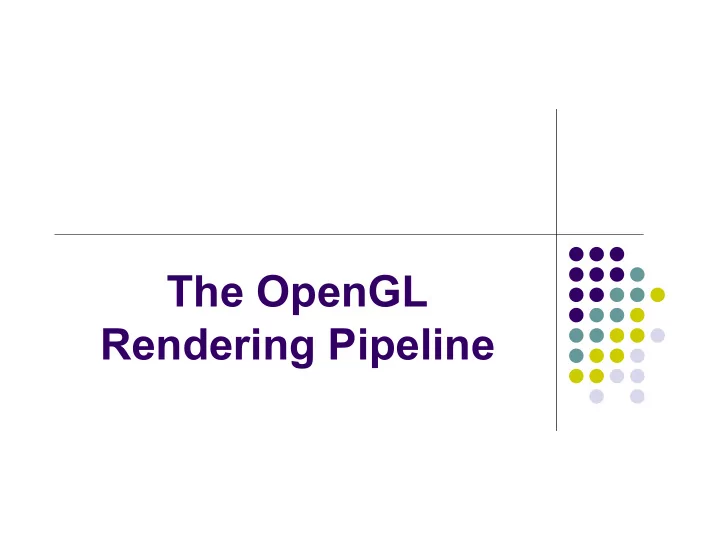

The OpenGL Rendering Pipeline
The Rendering Pipeline The process to generate two-dimensional images from given virtual cameras and 3D objects The pipeline stages implement various core graphics rendering algorithms Why should you know the pipeline? Understand various graphics algorithms Program low level graphics systems Necessary for programming GPUs Help analyze the performance bottleneck
The Rendering Pipeline The basic construction – Application three conceptual stages Each stage is a pipeline and runs in parallel Geometry Graphics performance is determined by the slowest stage Modern graphics systems: Rasteriazer software: hardware: Image
The Rendering Pipeline
The Geometry Stage (local space polygons) eye space Modeling and Viewing Vertex Lighting Projection clip space screen space Viewport Perspective Clipping Mapping Divide to rasterizer stage (screen space lit polygon vertices)
Transformation Pipeline Another view of the graphics pipeline Local (Object) ModelView Eye Space Space transformation Perspective Projection Clip Space devide transformation Scale and NDC space Window space translate N ormalized D evice C oordinates
Different Spaces Local space A space where you define the vertex coordinates, normals, etc. This is before any transformations are taking place These coordinates/normals are multiplied by the OpenGL modelview (VM) matrix into the eye space Modelview matrix: Viewing transformation matrix (V) multiplied by modeling transformation matrix (M), i.e., GL_MODELVIEW = V * M OpenGL matrix stack is used to allow different modelview matrices for different objects
Different Spaces (cont’d) Eye space Where per vertex lighting calculation is occurred Camera is at (0,0,0) and view’s up direction is by default (0,1,0) Light position is stored in this space after being multiplied by the OpenGL modelview matrix Vertex normals are consumed by the pipeline in this space by the lighting equation
Different Spaces (cont’d) Clip Space After projection and before perspective divide Clipping against view frustum done in this space -W <= X <= W; -W <=Y <=W; -W <=Z <=W; New vertices are generated as a result of clipping The view frustum after transformation is a parallelepiped regardless of orthographic or perspective projection Perspective Divide Transform clip space into NDC space Divide (x,y,z,w) by w where w = z/-d (d=1 in OpenGL so w = -z) Result in foreshortening effect
Different Spaces (cont’d) Window Space Map the NDC coordinates into the window X and Y are integers, relative to the lower left corner of the window Z are scaled and biased to [0,1] Rasterization is performed in this space The geometry processing ends in this space
The Geometry Stage Transform coordinates and normal Model->world World->eye Normalize the normal vectors Compute vertex lighting Generate (if necessary) and transform texture coordinates Transform to clip space (by projection) Assemble vertices into primitives Clip against viewing frustum Divide by w (perspective divide if applies) Viewport transformation Back face culling Introduce vertex dependences
The Rasterizer Stage Per-pixel operation: assign colors to the pixels in the frame buffer (a.k.a scan conversion) Main steps: (frame buffer) Setup Sampling (convert a primitive to fragments) Texture lookup and Interpolation (lighting, texturing, z values, etc) Color combinations (illumination and texture colors) Fogging Other pixel tests (scissor, alpha, stencil tests etc) Visibility (depth test) Blending/compositing/Logic op
The Rasterization Stage Convert each primitive into fragments (not pixels) Fragment: transient data structures position (x,y); depth; color; texture coordinates; etc Fragments from the rasterized polygons are then selected (z buffer comparison for instance) to form the frame buffer pixels
The Rasterization Stage Two main operations Fragment selection: generate one fragment for each pixel that is intersected by the primitive Fragment assignment: sample the primitive properties (colors, depths, etc) for each fragment - nearest neighbor continuity, linear interpolation, etc
Polygon Scan Conversion The goal is to compute the scanline-primitive intersections OpenGL Spec does not specify any particular algorithm to use Brute Force: try to intersect each scanline with all edges as we go from ymin to ymax We can do better Find ymin and ymax for each edge and only test the edge with scanlines in between For each edge, only calculate the intersection with the ymin; calculate dx/dy; calculate the new intersection as y=y+1, x +dx/dy Change x=x+dx/dy to integer arithmetic (such as using Bresenham’s algorithm)
Rasterization steps Texture interpolation Color interpolation Fog (blend the fog color with the fragment color based on the depth value) Scissor test (test against a rectangular region) Alpha test (compare with alpha, keep or drop it) Stencil test(mask the fragment depending on the content of the stencil buffer) Depth test (z buffer algorithm) Alpha blending Dithering (make the color look better for low res display mode)
Recommend
More recommend